Advanced Critical Thinking: Clinical Reasoning in Nursing Practice
VerifiedAdded on 2020/02/18
|10
|2647
|122
Essay
AI Summary
This essay meticulously examines the clinical reasoning cycle, a crucial framework for registered nurses in their practice. It begins with an introduction to the cycle, emphasizing its importance in patient care and positive outcomes. The essay then presents a detailed case study of a 90-year-old patient, Mrs. Sunning Hill, admitted to a medical surgery ward with an abdominal wound and hearing impairment, walking through each stage of the cycle: considering the situation, collecting information, processing data, identifying the problem, establishing goals, taking action, evaluating the interventions, and reflecting on the process. The analysis incorporates the student nurse's observations, assessments, and interventions, including the use of fluid balance charts, urine output calculations, and the adult deterioration detection system chart. The essay highlights the identification of a urinary tract infection and the subsequent actions taken, such as antibiotic administration and wound care. The reflection section emphasizes the importance of proper documentation, palliative care, and critical thinking in preventing future complications. Finally, the essay concludes with recommendations for improving nursing practice, such as enhanced documentation, patient communication, and the strategic use of the clinical reasoning cycle in all aspects of diagnosis and treatment.
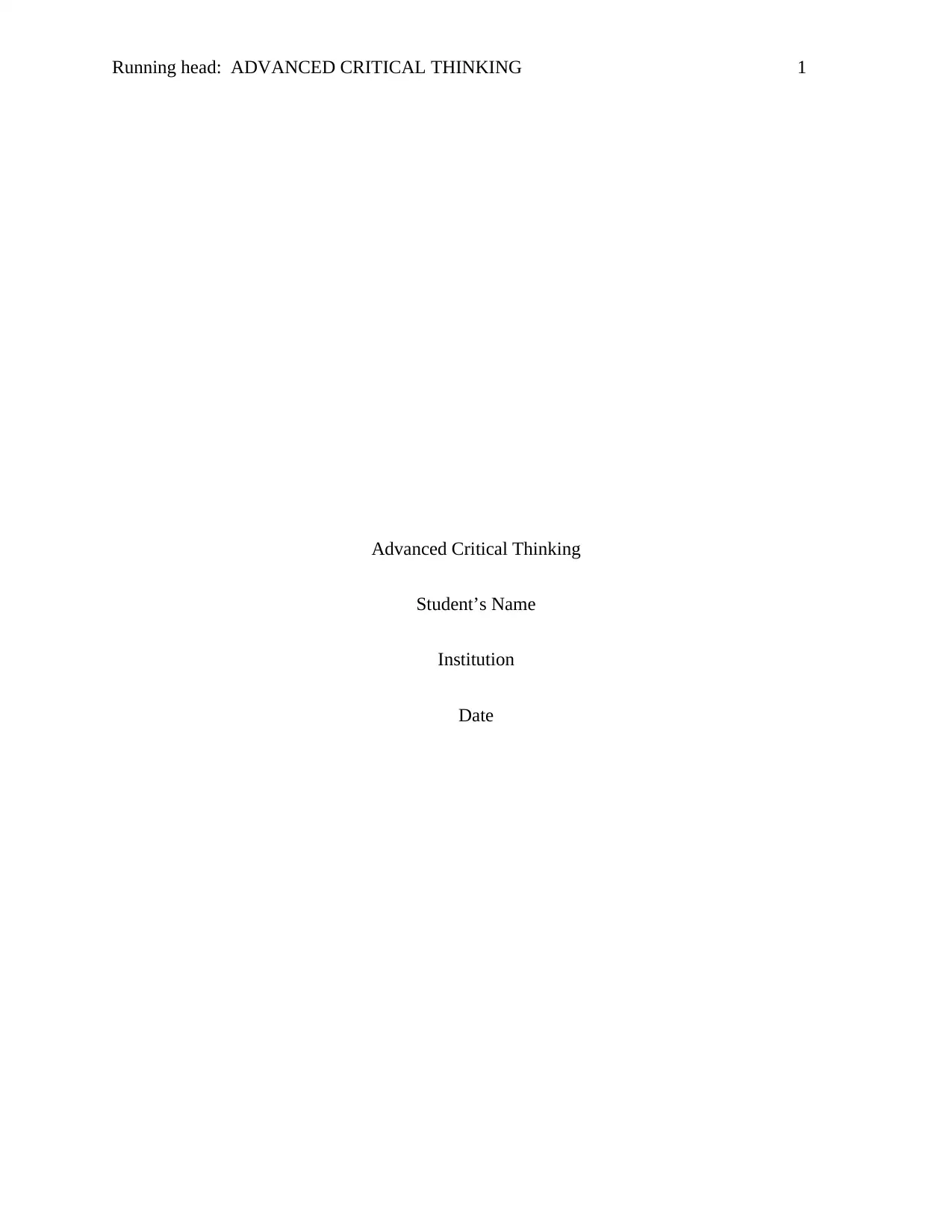
Running head: ADVANCED CRITICAL THINKING 1
Advanced Critical Thinking
Student’s Name
Institution
Date
Advanced Critical Thinking
Student’s Name
Institution
Date
Paraphrase This Document
Need a fresh take? Get an instant paraphrase of this document with our AI Paraphraser
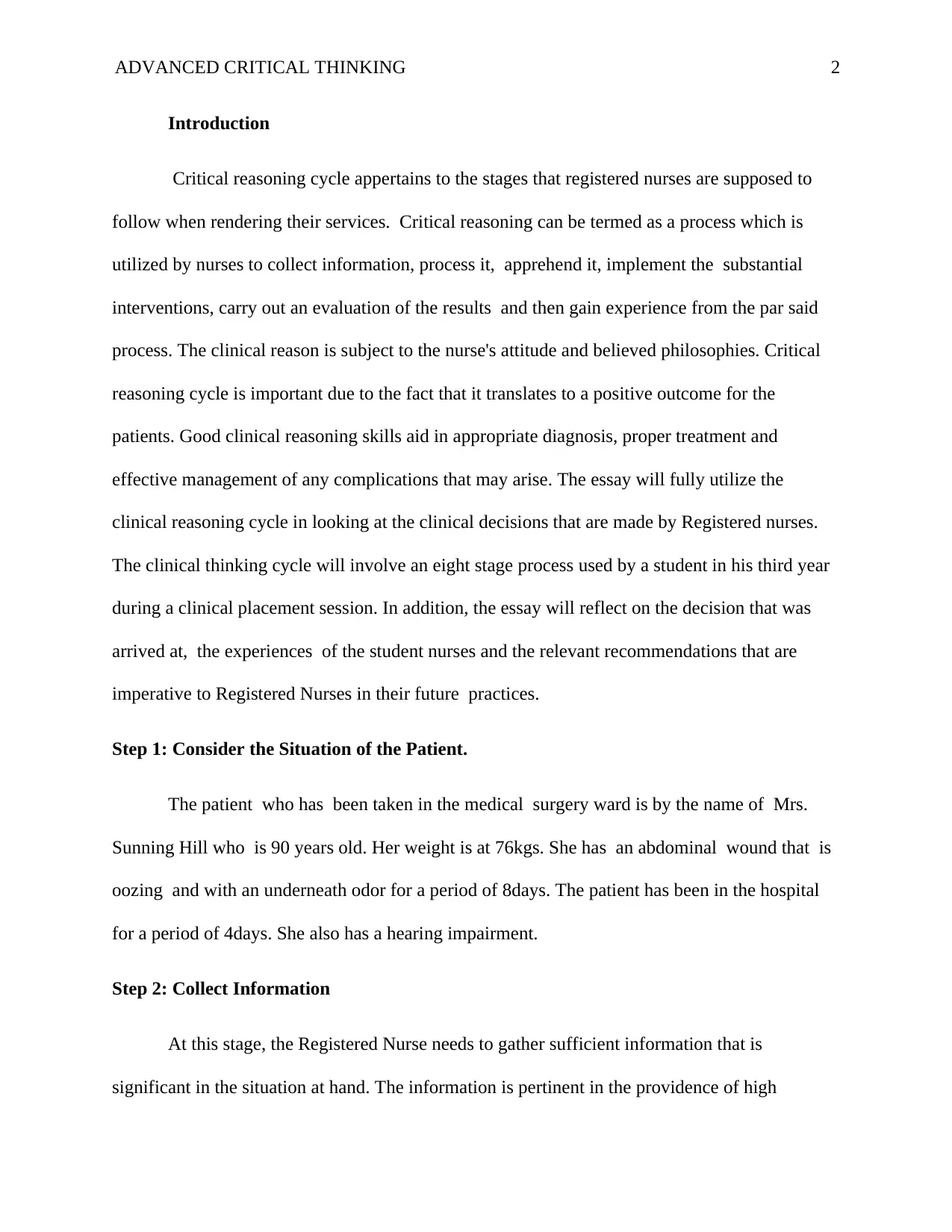
ADVANCED CRITICAL THINKING 2
Introduction
Critical reasoning cycle appertains to the stages that registered nurses are supposed to
follow when rendering their services. Critical reasoning can be termed as a process which is
utilized by nurses to collect information, process it, apprehend it, implement the substantial
interventions, carry out an evaluation of the results and then gain experience from the par said
process. The clinical reason is subject to the nurse's attitude and believed philosophies. Critical
reasoning cycle is important due to the fact that it translates to a positive outcome for the
patients. Good clinical reasoning skills aid in appropriate diagnosis, proper treatment and
effective management of any complications that may arise. The essay will fully utilize the
clinical reasoning cycle in looking at the clinical decisions that are made by Registered nurses.
The clinical thinking cycle will involve an eight stage process used by a student in his third year
during a clinical placement session. In addition, the essay will reflect on the decision that was
arrived at, the experiences of the student nurses and the relevant recommendations that are
imperative to Registered Nurses in their future practices.
Step 1: Consider the Situation of the Patient.
The patient who has been taken in the medical surgery ward is by the name of Mrs.
Sunning Hill who is 90 years old. Her weight is at 76kgs. She has an abdominal wound that is
oozing and with an underneath odor for a period of 8days. The patient has been in the hospital
for a period of 4days. She also has a hearing impairment.
Step 2: Collect Information
At this stage, the Registered Nurse needs to gather sufficient information that is
significant in the situation at hand. The information is pertinent in the providence of high
Introduction
Critical reasoning cycle appertains to the stages that registered nurses are supposed to
follow when rendering their services. Critical reasoning can be termed as a process which is
utilized by nurses to collect information, process it, apprehend it, implement the substantial
interventions, carry out an evaluation of the results and then gain experience from the par said
process. The clinical reason is subject to the nurse's attitude and believed philosophies. Critical
reasoning cycle is important due to the fact that it translates to a positive outcome for the
patients. Good clinical reasoning skills aid in appropriate diagnosis, proper treatment and
effective management of any complications that may arise. The essay will fully utilize the
clinical reasoning cycle in looking at the clinical decisions that are made by Registered nurses.
The clinical thinking cycle will involve an eight stage process used by a student in his third year
during a clinical placement session. In addition, the essay will reflect on the decision that was
arrived at, the experiences of the student nurses and the relevant recommendations that are
imperative to Registered Nurses in their future practices.
Step 1: Consider the Situation of the Patient.
The patient who has been taken in the medical surgery ward is by the name of Mrs.
Sunning Hill who is 90 years old. Her weight is at 76kgs. She has an abdominal wound that is
oozing and with an underneath odor for a period of 8days. The patient has been in the hospital
for a period of 4days. She also has a hearing impairment.
Step 2: Collect Information
At this stage, the Registered Nurse needs to gather sufficient information that is
significant in the situation at hand. The information is pertinent in the providence of high
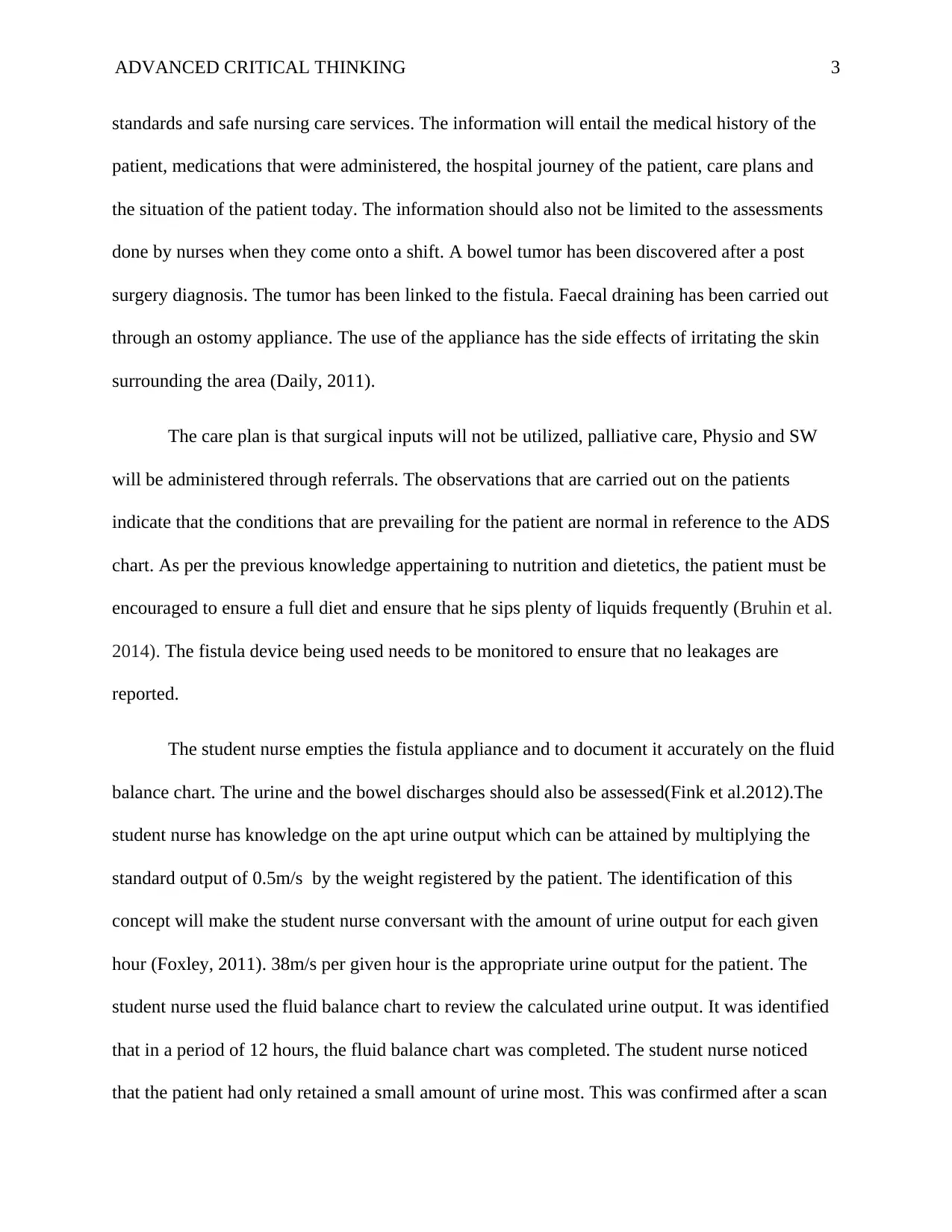
ADVANCED CRITICAL THINKING 3
standards and safe nursing care services. The information will entail the medical history of the
patient, medications that were administered, the hospital journey of the patient, care plans and
the situation of the patient today. The information should also not be limited to the assessments
done by nurses when they come onto a shift. A bowel tumor has been discovered after a post
surgery diagnosis. The tumor has been linked to the fistula. Faecal draining has been carried out
through an ostomy appliance. The use of the appliance has the side effects of irritating the skin
surrounding the area (Daily, 2011).
The care plan is that surgical inputs will not be utilized, palliative care, Physio and SW
will be administered through referrals. The observations that are carried out on the patients
indicate that the conditions that are prevailing for the patient are normal in reference to the ADS
chart. As per the previous knowledge appertaining to nutrition and dietetics, the patient must be
encouraged to ensure a full diet and ensure that he sips plenty of liquids frequently (Bruhin et al.
2014). The fistula device being used needs to be monitored to ensure that no leakages are
reported.
The student nurse empties the fistula appliance and to document it accurately on the fluid
balance chart. The urine and the bowel discharges should also be assessed(Fink et al.2012).The
student nurse has knowledge on the apt urine output which can be attained by multiplying the
standard output of 0.5m/s by the weight registered by the patient. The identification of this
concept will make the student nurse conversant with the amount of urine output for each given
hour (Foxley, 2011). 38m/s per given hour is the appropriate urine output for the patient. The
student nurse used the fluid balance chart to review the calculated urine output. It was identified
that in a period of 12 hours, the fluid balance chart was completed. The student nurse noticed
that the patient had only retained a small amount of urine most. This was confirmed after a scan
standards and safe nursing care services. The information will entail the medical history of the
patient, medications that were administered, the hospital journey of the patient, care plans and
the situation of the patient today. The information should also not be limited to the assessments
done by nurses when they come onto a shift. A bowel tumor has been discovered after a post
surgery diagnosis. The tumor has been linked to the fistula. Faecal draining has been carried out
through an ostomy appliance. The use of the appliance has the side effects of irritating the skin
surrounding the area (Daily, 2011).
The care plan is that surgical inputs will not be utilized, palliative care, Physio and SW
will be administered through referrals. The observations that are carried out on the patients
indicate that the conditions that are prevailing for the patient are normal in reference to the ADS
chart. As per the previous knowledge appertaining to nutrition and dietetics, the patient must be
encouraged to ensure a full diet and ensure that he sips plenty of liquids frequently (Bruhin et al.
2014). The fistula device being used needs to be monitored to ensure that no leakages are
reported.
The student nurse empties the fistula appliance and to document it accurately on the fluid
balance chart. The urine and the bowel discharges should also be assessed(Fink et al.2012).The
student nurse has knowledge on the apt urine output which can be attained by multiplying the
standard output of 0.5m/s by the weight registered by the patient. The identification of this
concept will make the student nurse conversant with the amount of urine output for each given
hour (Foxley, 2011). 38m/s per given hour is the appropriate urine output for the patient. The
student nurse used the fluid balance chart to review the calculated urine output. It was identified
that in a period of 12 hours, the fluid balance chart was completed. The student nurse noticed
that the patient had only retained a small amount of urine most. This was confirmed after a scan
⊘ This is a preview!⊘
Do you want full access?
Subscribe today to unlock all pages.

Trusted by 1+ million students worldwide
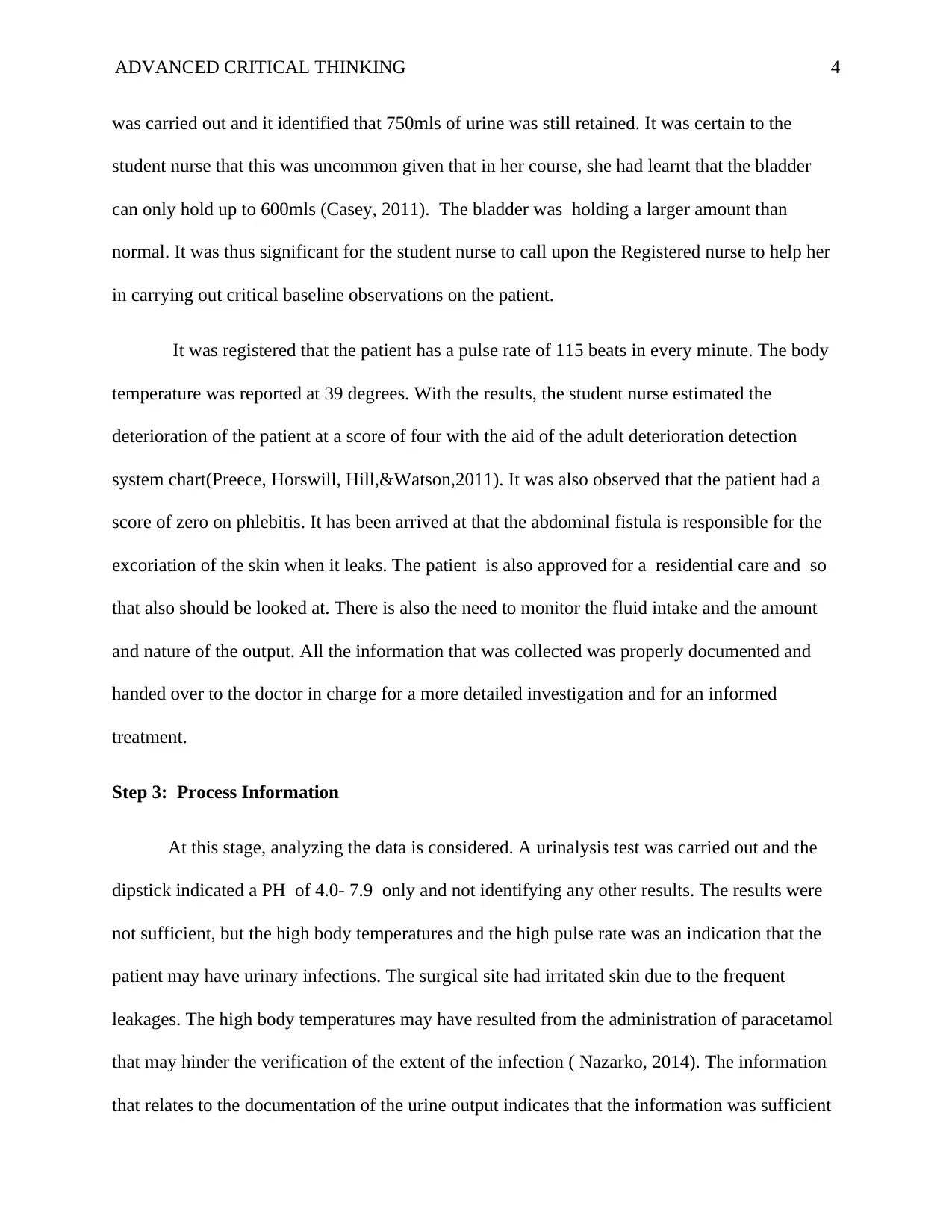
ADVANCED CRITICAL THINKING 4
was carried out and it identified that 750mls of urine was still retained. It was certain to the
student nurse that this was uncommon given that in her course, she had learnt that the bladder
can only hold up to 600mls (Casey, 2011). The bladder was holding a larger amount than
normal. It was thus significant for the student nurse to call upon the Registered nurse to help her
in carrying out critical baseline observations on the patient.
It was registered that the patient has a pulse rate of 115 beats in every minute. The body
temperature was reported at 39 degrees. With the results, the student nurse estimated the
deterioration of the patient at a score of four with the aid of the adult deterioration detection
system chart(Preece, Horswill, Hill,&Watson,2011). It was also observed that the patient had a
score of zero on phlebitis. It has been arrived at that the abdominal fistula is responsible for the
excoriation of the skin when it leaks. The patient is also approved for a residential care and so
that also should be looked at. There is also the need to monitor the fluid intake and the amount
and nature of the output. All the information that was collected was properly documented and
handed over to the doctor in charge for a more detailed investigation and for an informed
treatment.
Step 3: Process Information
At this stage, analyzing the data is considered. A urinalysis test was carried out and the
dipstick indicated a PH of 4.0- 7.9 only and not identifying any other results. The results were
not sufficient, but the high body temperatures and the high pulse rate was an indication that the
patient may have urinary infections. The surgical site had irritated skin due to the frequent
leakages. The high body temperatures may have resulted from the administration of paracetamol
that may hinder the verification of the extent of the infection ( Nazarko, 2014). The information
that relates to the documentation of the urine output indicates that the information was sufficient
was carried out and it identified that 750mls of urine was still retained. It was certain to the
student nurse that this was uncommon given that in her course, she had learnt that the bladder
can only hold up to 600mls (Casey, 2011). The bladder was holding a larger amount than
normal. It was thus significant for the student nurse to call upon the Registered nurse to help her
in carrying out critical baseline observations on the patient.
It was registered that the patient has a pulse rate of 115 beats in every minute. The body
temperature was reported at 39 degrees. With the results, the student nurse estimated the
deterioration of the patient at a score of four with the aid of the adult deterioration detection
system chart(Preece, Horswill, Hill,&Watson,2011). It was also observed that the patient had a
score of zero on phlebitis. It has been arrived at that the abdominal fistula is responsible for the
excoriation of the skin when it leaks. The patient is also approved for a residential care and so
that also should be looked at. There is also the need to monitor the fluid intake and the amount
and nature of the output. All the information that was collected was properly documented and
handed over to the doctor in charge for a more detailed investigation and for an informed
treatment.
Step 3: Process Information
At this stage, analyzing the data is considered. A urinalysis test was carried out and the
dipstick indicated a PH of 4.0- 7.9 only and not identifying any other results. The results were
not sufficient, but the high body temperatures and the high pulse rate was an indication that the
patient may have urinary infections. The surgical site had irritated skin due to the frequent
leakages. The high body temperatures may have resulted from the administration of paracetamol
that may hinder the verification of the extent of the infection ( Nazarko, 2014). The information
that relates to the documentation of the urine output indicates that the information was sufficient
Paraphrase This Document
Need a fresh take? Get an instant paraphrase of this document with our AI Paraphraser
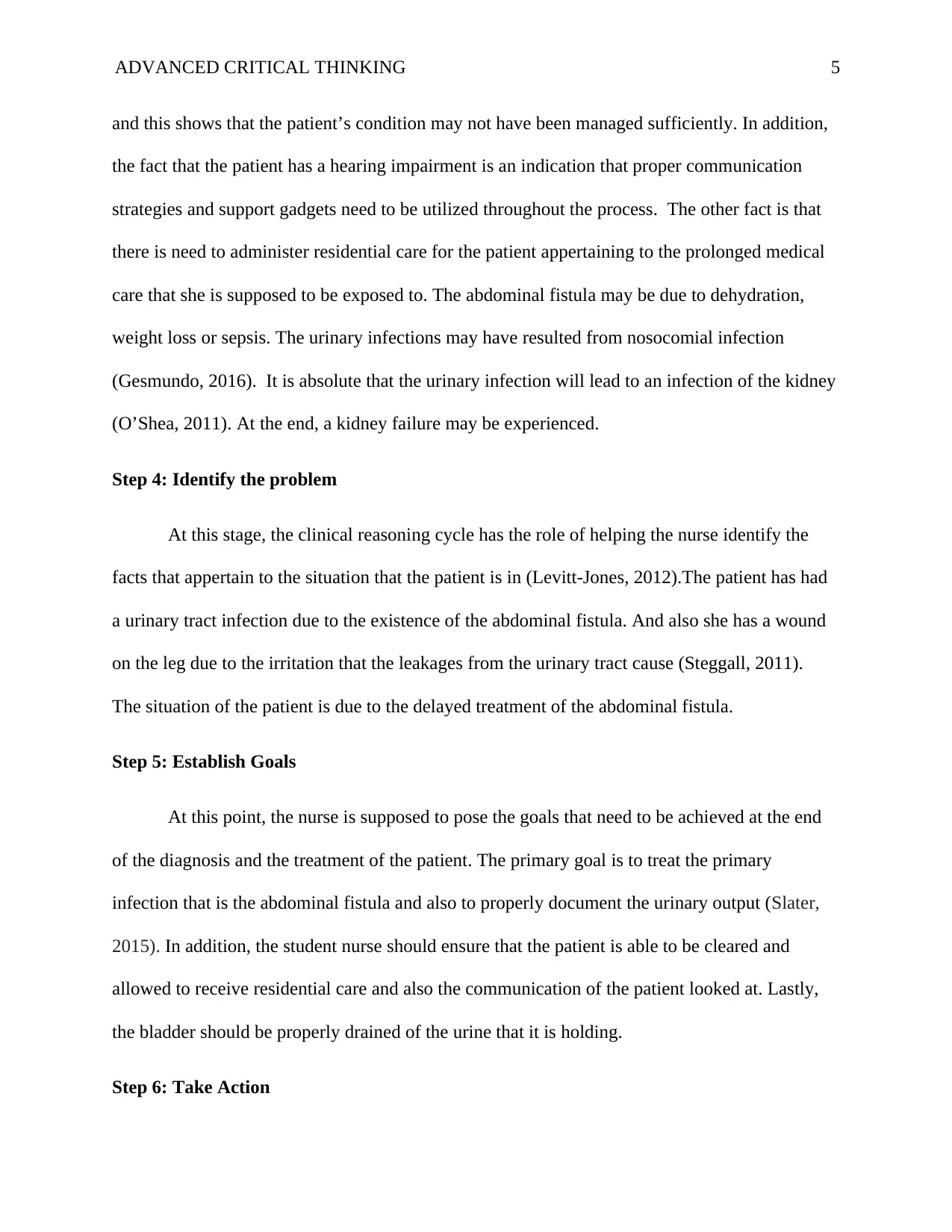
ADVANCED CRITICAL THINKING 5
and this shows that the patient’s condition may not have been managed sufficiently. In addition,
the fact that the patient has a hearing impairment is an indication that proper communication
strategies and support gadgets need to be utilized throughout the process. The other fact is that
there is need to administer residential care for the patient appertaining to the prolonged medical
care that she is supposed to be exposed to. The abdominal fistula may be due to dehydration,
weight loss or sepsis. The urinary infections may have resulted from nosocomial infection
(Gesmundo, 2016). It is absolute that the urinary infection will lead to an infection of the kidney
(O’Shea, 2011). At the end, a kidney failure may be experienced.
Step 4: Identify the problem
At this stage, the clinical reasoning cycle has the role of helping the nurse identify the
facts that appertain to the situation that the patient is in (Levitt-Jones, 2012).The patient has had
a urinary tract infection due to the existence of the abdominal fistula. And also she has a wound
on the leg due to the irritation that the leakages from the urinary tract cause (Steggall, 2011).
The situation of the patient is due to the delayed treatment of the abdominal fistula.
Step 5: Establish Goals
At this point, the nurse is supposed to pose the goals that need to be achieved at the end
of the diagnosis and the treatment of the patient. The primary goal is to treat the primary
infection that is the abdominal fistula and also to properly document the urinary output (Slater,
2015). In addition, the student nurse should ensure that the patient is able to be cleared and
allowed to receive residential care and also the communication of the patient looked at. Lastly,
the bladder should be properly drained of the urine that it is holding.
Step 6: Take Action
and this shows that the patient’s condition may not have been managed sufficiently. In addition,
the fact that the patient has a hearing impairment is an indication that proper communication
strategies and support gadgets need to be utilized throughout the process. The other fact is that
there is need to administer residential care for the patient appertaining to the prolonged medical
care that she is supposed to be exposed to. The abdominal fistula may be due to dehydration,
weight loss or sepsis. The urinary infections may have resulted from nosocomial infection
(Gesmundo, 2016). It is absolute that the urinary infection will lead to an infection of the kidney
(O’Shea, 2011). At the end, a kidney failure may be experienced.
Step 4: Identify the problem
At this stage, the clinical reasoning cycle has the role of helping the nurse identify the
facts that appertain to the situation that the patient is in (Levitt-Jones, 2012).The patient has had
a urinary tract infection due to the existence of the abdominal fistula. And also she has a wound
on the leg due to the irritation that the leakages from the urinary tract cause (Steggall, 2011).
The situation of the patient is due to the delayed treatment of the abdominal fistula.
Step 5: Establish Goals
At this point, the nurse is supposed to pose the goals that need to be achieved at the end
of the diagnosis and the treatment of the patient. The primary goal is to treat the primary
infection that is the abdominal fistula and also to properly document the urinary output (Slater,
2015). In addition, the student nurse should ensure that the patient is able to be cleared and
allowed to receive residential care and also the communication of the patient looked at. Lastly,
the bladder should be properly drained of the urine that it is holding.
Step 6: Take Action
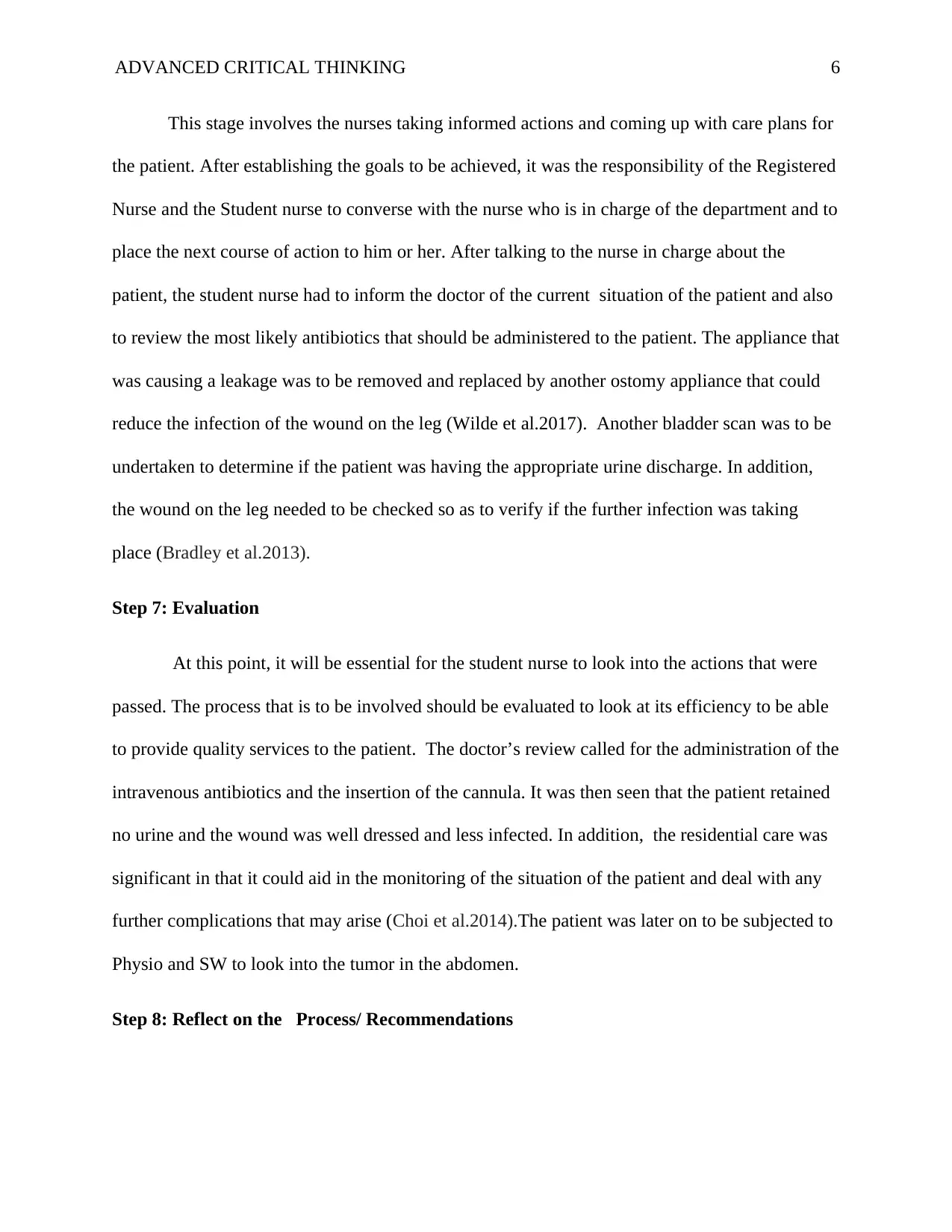
ADVANCED CRITICAL THINKING 6
This stage involves the nurses taking informed actions and coming up with care plans for
the patient. After establishing the goals to be achieved, it was the responsibility of the Registered
Nurse and the Student nurse to converse with the nurse who is in charge of the department and to
place the next course of action to him or her. After talking to the nurse in charge about the
patient, the student nurse had to inform the doctor of the current situation of the patient and also
to review the most likely antibiotics that should be administered to the patient. The appliance that
was causing a leakage was to be removed and replaced by another ostomy appliance that could
reduce the infection of the wound on the leg (Wilde et al.2017). Another bladder scan was to be
undertaken to determine if the patient was having the appropriate urine discharge. In addition,
the wound on the leg needed to be checked so as to verify if the further infection was taking
place (Bradley et al.2013).
Step 7: Evaluation
At this point, it will be essential for the student nurse to look into the actions that were
passed. The process that is to be involved should be evaluated to look at its efficiency to be able
to provide quality services to the patient. The doctor’s review called for the administration of the
intravenous antibiotics and the insertion of the cannula. It was then seen that the patient retained
no urine and the wound was well dressed and less infected. In addition, the residential care was
significant in that it could aid in the monitoring of the situation of the patient and deal with any
further complications that may arise (Choi et al.2014).The patient was later on to be subjected to
Physio and SW to look into the tumor in the abdomen.
Step 8: Reflect on the Process/ Recommendations
This stage involves the nurses taking informed actions and coming up with care plans for
the patient. After establishing the goals to be achieved, it was the responsibility of the Registered
Nurse and the Student nurse to converse with the nurse who is in charge of the department and to
place the next course of action to him or her. After talking to the nurse in charge about the
patient, the student nurse had to inform the doctor of the current situation of the patient and also
to review the most likely antibiotics that should be administered to the patient. The appliance that
was causing a leakage was to be removed and replaced by another ostomy appliance that could
reduce the infection of the wound on the leg (Wilde et al.2017). Another bladder scan was to be
undertaken to determine if the patient was having the appropriate urine discharge. In addition,
the wound on the leg needed to be checked so as to verify if the further infection was taking
place (Bradley et al.2013).
Step 7: Evaluation
At this point, it will be essential for the student nurse to look into the actions that were
passed. The process that is to be involved should be evaluated to look at its efficiency to be able
to provide quality services to the patient. The doctor’s review called for the administration of the
intravenous antibiotics and the insertion of the cannula. It was then seen that the patient retained
no urine and the wound was well dressed and less infected. In addition, the residential care was
significant in that it could aid in the monitoring of the situation of the patient and deal with any
further complications that may arise (Choi et al.2014).The patient was later on to be subjected to
Physio and SW to look into the tumor in the abdomen.
Step 8: Reflect on the Process/ Recommendations
⊘ This is a preview!⊘
Do you want full access?
Subscribe today to unlock all pages.

Trusted by 1+ million students worldwide
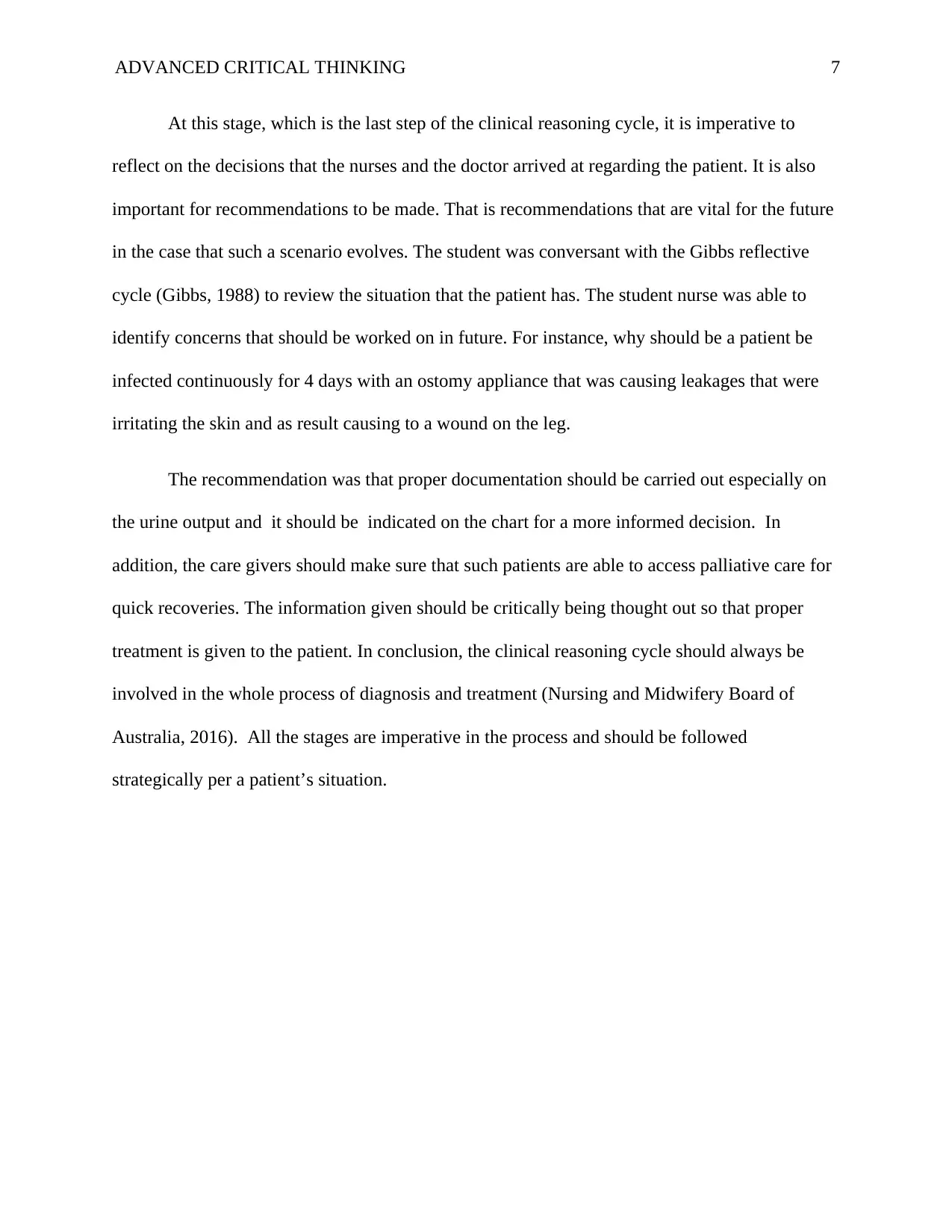
ADVANCED CRITICAL THINKING 7
At this stage, which is the last step of the clinical reasoning cycle, it is imperative to
reflect on the decisions that the nurses and the doctor arrived at regarding the patient. It is also
important for recommendations to be made. That is recommendations that are vital for the future
in the case that such a scenario evolves. The student was conversant with the Gibbs reflective
cycle (Gibbs, 1988) to review the situation that the patient has. The student nurse was able to
identify concerns that should be worked on in future. For instance, why should be a patient be
infected continuously for 4 days with an ostomy appliance that was causing leakages that were
irritating the skin and as result causing to a wound on the leg.
The recommendation was that proper documentation should be carried out especially on
the urine output and it should be indicated on the chart for a more informed decision. In
addition, the care givers should make sure that such patients are able to access palliative care for
quick recoveries. The information given should be critically being thought out so that proper
treatment is given to the patient. In conclusion, the clinical reasoning cycle should always be
involved in the whole process of diagnosis and treatment (Nursing and Midwifery Board of
Australia, 2016). All the stages are imperative in the process and should be followed
strategically per a patient’s situation.
At this stage, which is the last step of the clinical reasoning cycle, it is imperative to
reflect on the decisions that the nurses and the doctor arrived at regarding the patient. It is also
important for recommendations to be made. That is recommendations that are vital for the future
in the case that such a scenario evolves. The student was conversant with the Gibbs reflective
cycle (Gibbs, 1988) to review the situation that the patient has. The student nurse was able to
identify concerns that should be worked on in future. For instance, why should be a patient be
infected continuously for 4 days with an ostomy appliance that was causing leakages that were
irritating the skin and as result causing to a wound on the leg.
The recommendation was that proper documentation should be carried out especially on
the urine output and it should be indicated on the chart for a more informed decision. In
addition, the care givers should make sure that such patients are able to access palliative care for
quick recoveries. The information given should be critically being thought out so that proper
treatment is given to the patient. In conclusion, the clinical reasoning cycle should always be
involved in the whole process of diagnosis and treatment (Nursing and Midwifery Board of
Australia, 2016). All the stages are imperative in the process and should be followed
strategically per a patient’s situation.
Paraphrase This Document
Need a fresh take? Get an instant paraphrase of this document with our AI Paraphraser
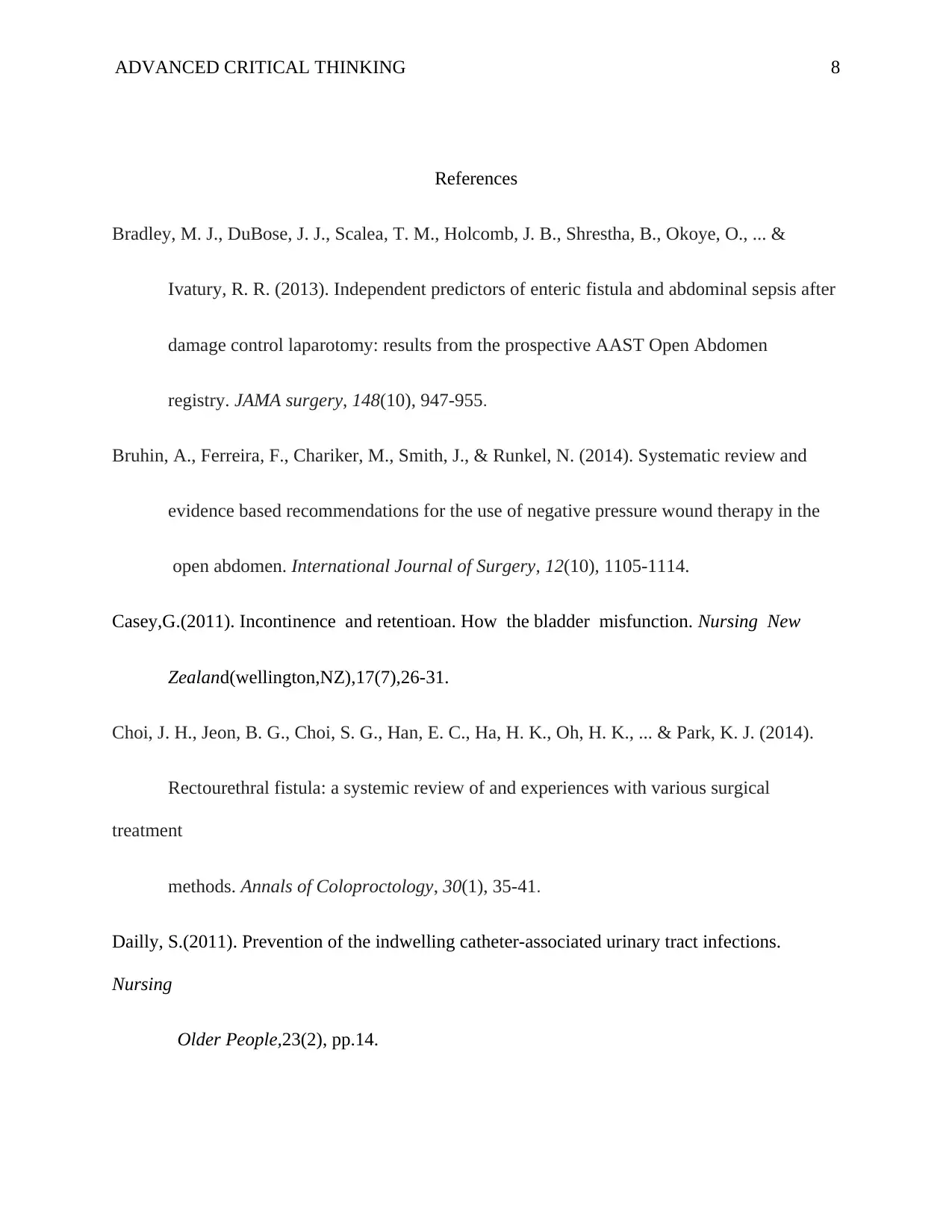
ADVANCED CRITICAL THINKING 8
References
Bradley, M. J., DuBose, J. J., Scalea, T. M., Holcomb, J. B., Shrestha, B., Okoye, O., ... &
Ivatury, R. R. (2013). Independent predictors of enteric fistula and abdominal sepsis after
damage control laparotomy: results from the prospective AAST Open Abdomen
registry. JAMA surgery, 148(10), 947-955.
Bruhin, A., Ferreira, F., Chariker, M., Smith, J., & Runkel, N. (2014). Systematic review and
evidence based recommendations for the use of negative pressure wound therapy in the
open abdomen. International Journal of Surgery, 12(10), 1105-1114.
Casey,G.(2011). Incontinence and retentioan. How the bladder misfunction. Nursing New
Zealand(wellington,NZ),17(7),26-31.
Choi, J. H., Jeon, B. G., Choi, S. G., Han, E. C., Ha, H. K., Oh, H. K., ... & Park, K. J. (2014).
Rectourethral fistula: a systemic review of and experiences with various surgical
treatment
methods. Annals of Coloproctology, 30(1), 35-41.
Dailly, S.(2011). Prevention of the indwelling catheter-associated urinary tract infections.
Nursing
Older People,23(2), pp.14.
References
Bradley, M. J., DuBose, J. J., Scalea, T. M., Holcomb, J. B., Shrestha, B., Okoye, O., ... &
Ivatury, R. R. (2013). Independent predictors of enteric fistula and abdominal sepsis after
damage control laparotomy: results from the prospective AAST Open Abdomen
registry. JAMA surgery, 148(10), 947-955.
Bruhin, A., Ferreira, F., Chariker, M., Smith, J., & Runkel, N. (2014). Systematic review and
evidence based recommendations for the use of negative pressure wound therapy in the
open abdomen. International Journal of Surgery, 12(10), 1105-1114.
Casey,G.(2011). Incontinence and retentioan. How the bladder misfunction. Nursing New
Zealand(wellington,NZ),17(7),26-31.
Choi, J. H., Jeon, B. G., Choi, S. G., Han, E. C., Ha, H. K., Oh, H. K., ... & Park, K. J. (2014).
Rectourethral fistula: a systemic review of and experiences with various surgical
treatment
methods. Annals of Coloproctology, 30(1), 35-41.
Dailly, S.(2011). Prevention of the indwelling catheter-associated urinary tract infections.
Nursing
Older People,23(2), pp.14.
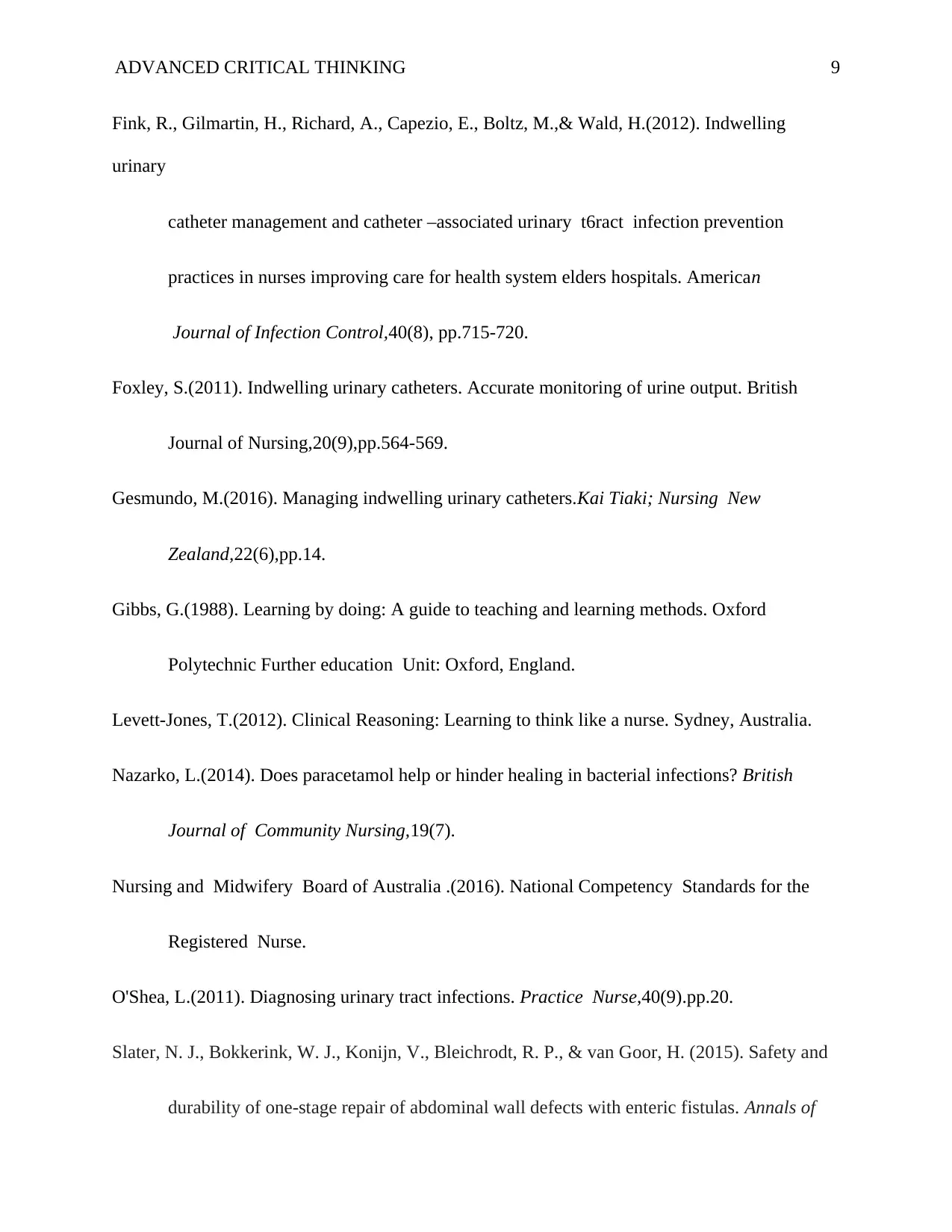
ADVANCED CRITICAL THINKING 9
Fink, R., Gilmartin, H., Richard, A., Capezio, E., Boltz, M.,& Wald, H.(2012). Indwelling
urinary
catheter management and catheter –associated urinary t6ract infection prevention
practices in nurses improving care for health system elders hospitals. American
Journal of Infection Control,40(8), pp.715-720.
Foxley, S.(2011). Indwelling urinary catheters. Accurate monitoring of urine output. British
Journal of Nursing,20(9),pp.564-569.
Gesmundo, M.(2016). Managing indwelling urinary catheters.Kai Tiaki; Nursing New
Zealand,22(6),pp.14.
Gibbs, G.(1988). Learning by doing: A guide to teaching and learning methods. Oxford
Polytechnic Further education Unit: Oxford, England.
Levett-Jones, T.(2012). Clinical Reasoning: Learning to think like a nurse. Sydney, Australia.
Nazarko, L.(2014). Does paracetamol help or hinder healing in bacterial infections? British
Journal of Community Nursing,19(7).
Nursing and Midwifery Board of Australia .(2016). National Competency Standards for the
Registered Nurse.
O'Shea, L.(2011). Diagnosing urinary tract infections. Practice Nurse,40(9).pp.20.
Slater, N. J., Bokkerink, W. J., Konijn, V., Bleichrodt, R. P., & van Goor, H. (2015). Safety and
durability of one-stage repair of abdominal wall defects with enteric fistulas. Annals of
Fink, R., Gilmartin, H., Richard, A., Capezio, E., Boltz, M.,& Wald, H.(2012). Indwelling
urinary
catheter management and catheter –associated urinary t6ract infection prevention
practices in nurses improving care for health system elders hospitals. American
Journal of Infection Control,40(8), pp.715-720.
Foxley, S.(2011). Indwelling urinary catheters. Accurate monitoring of urine output. British
Journal of Nursing,20(9),pp.564-569.
Gesmundo, M.(2016). Managing indwelling urinary catheters.Kai Tiaki; Nursing New
Zealand,22(6),pp.14.
Gibbs, G.(1988). Learning by doing: A guide to teaching and learning methods. Oxford
Polytechnic Further education Unit: Oxford, England.
Levett-Jones, T.(2012). Clinical Reasoning: Learning to think like a nurse. Sydney, Australia.
Nazarko, L.(2014). Does paracetamol help or hinder healing in bacterial infections? British
Journal of Community Nursing,19(7).
Nursing and Midwifery Board of Australia .(2016). National Competency Standards for the
Registered Nurse.
O'Shea, L.(2011). Diagnosing urinary tract infections. Practice Nurse,40(9).pp.20.
Slater, N. J., Bokkerink, W. J., Konijn, V., Bleichrodt, R. P., & van Goor, H. (2015). Safety and
durability of one-stage repair of abdominal wall defects with enteric fistulas. Annals of
⊘ This is a preview!⊘
Do you want full access?
Subscribe today to unlock all pages.

Trusted by 1+ million students worldwide
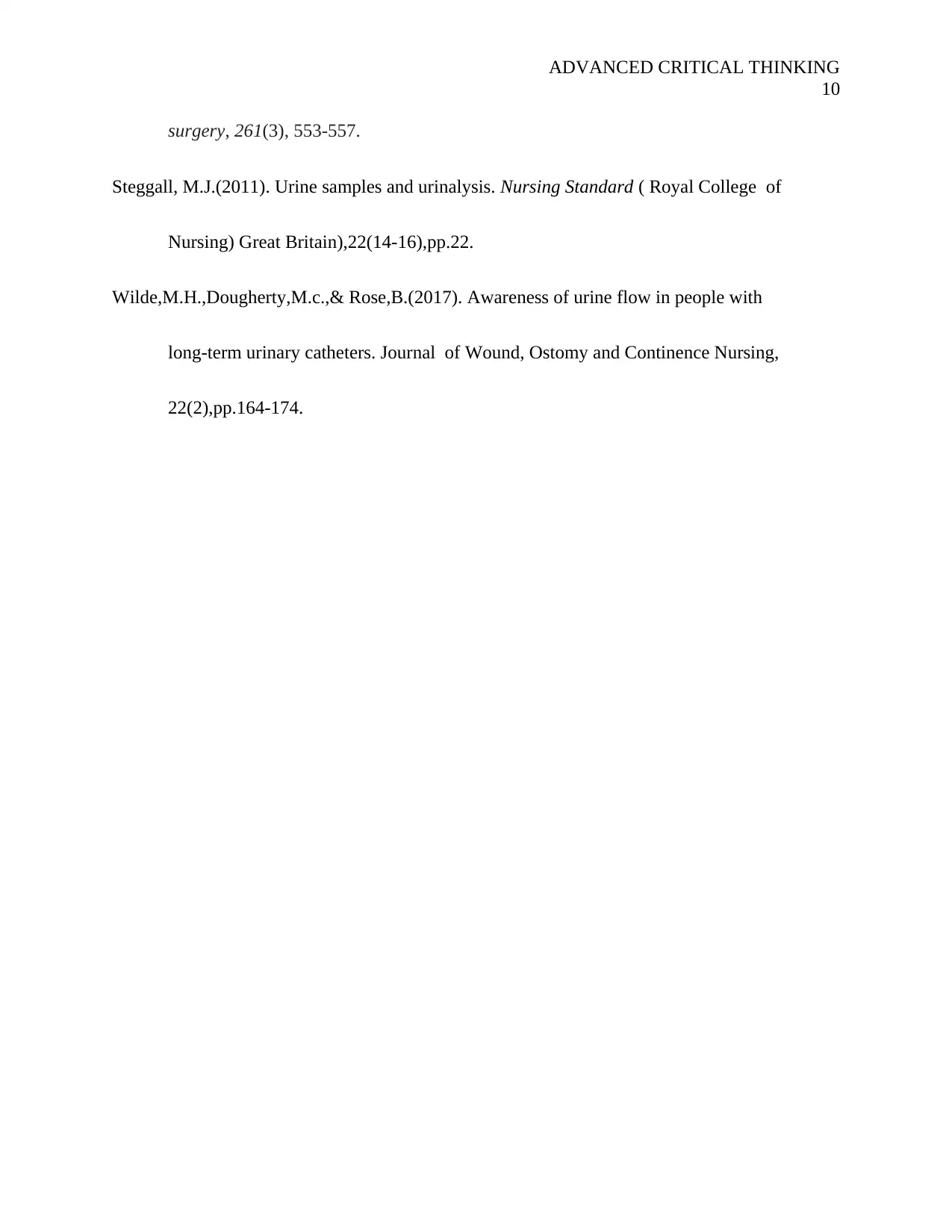
ADVANCED CRITICAL THINKING
10
surgery, 261(3), 553-557.
Steggall, M.J.(2011). Urine samples and urinalysis. Nursing Standard ( Royal College of
Nursing) Great Britain),22(14-16),pp.22.
Wilde,M.H.,Dougherty,M.c.,& Rose,B.(2017). Awareness of urine flow in people with
long-term urinary catheters. Journal of Wound, Ostomy and Continence Nursing,
22(2),pp.164-174.
10
surgery, 261(3), 553-557.
Steggall, M.J.(2011). Urine samples and urinalysis. Nursing Standard ( Royal College of
Nursing) Great Britain),22(14-16),pp.22.
Wilde,M.H.,Dougherty,M.c.,& Rose,B.(2017). Awareness of urine flow in people with
long-term urinary catheters. Journal of Wound, Ostomy and Continence Nursing,
22(2),pp.164-174.
1 out of 10
Related Documents
Your All-in-One AI-Powered Toolkit for Academic Success.
+13062052269
info@desklib.com
Available 24*7 on WhatsApp / Email
![[object Object]](/_next/static/media/star-bottom.7253800d.svg)
Unlock your academic potential
Copyright © 2020–2025 A2Z Services. All Rights Reserved. Developed and managed by ZUCOL.





